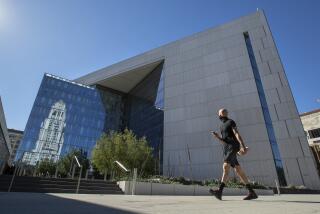Decline in Crime Ending, FBI Says
WASHINGTON — An unprecedented drop in crime has come to an end, with the number of crimes bottoming out nationwide and creeping upward in Western states for the first time in a decade, according to FBI data released Wednesday.
The trend triggered new concern that a sagging economy, a record number of parolees and other factors could fuel a return to the high crime rates of the early 1990s.
“The great 1990s crime drop is officially over,” declared James Alan Fox, a criminologist at Northeastern University.
The rise in California and other Western states is fairly modest--a 1.1% increase in the number of serious crimes from 1999 to 2000--but it marks the first time since 1991 that there has been any increase at all in the West, the preliminary FBI figures showed.
Some California cities showed particularly significant jumps in crime. Los Angeles, which has struggled for months to combat a sharp rise in murders, saw serious crime rise 7.8% last year, while Fontana saw a jump of 14.2%, Fresno 14%, Pasadena 13.1% and Burbank 12.8%. But other major cities--including Oakland, San Jose and San Diego--continued to show major declines.
Of cities with at least 100,000 residents, nine of the top 10 with the lowest crime rates are in California, the FBI reported. The No. 1 spot went to Simi Valley, followed by Thousand Oaks and Santa Clarita. Orange County has six cities in the top-25 ranking.
Theories abound, but no one is quite sure why crime is climbing after years of steep and unprecedented declines.
“That’s the million-dollar question,” LAPD Sgt. John Pasquariello said in an interview. “Our analysis just doesn’t show any one thing. No one has the magic formula--whether it’s the economy, more people getting out of prison, we just don’t know.”
Nationwide, eight straight years of declining crime also came to an end, with the crime index virtually unchanged last year from 1999, the FBI said. Violent crime, which includes murder, rape, robbery and aggravated assault, rose just slightly nationwide, by one-tenth of a percent, while property crime showed no change.
The plummeting crime rate--the longest such decline since federal officials began keeping such records in the 1930s--had shown clear signs of stalling last December after reaching its lowest point in three decades, and Wednesday’s statistics confirmed the plateau.
Said crime expert Jeremy Travis, senior fellow at the nonpartisan Urban Institute in Washington: “We knew the declines couldn’t continue at the rapid pace of the ‘90s forever. What this means is that it’s time to pay attention to what’s happening in our large cities in particular and to find ways of increasing the safety of our communities.”
Burglary Shows Biggest Decline
The FBI tracked serious crimes in the United States last year--defined as murder, rape, robbery, aggravated assault, burglary, larceny, motor-vehicle theft and arson. Motor-vehicle thefts jumped 2.7%, the biggest increase in any single type of crime nationwide, while burglary saw the largest decline at 2.1%.
Wednesday’s figures, based on voluntary reports from 17,000 law enforcement agencies around the country, are preliminary and could change by the time the FBI puts out a final and more detailed crime report later this year.
The spike in motor-vehicle thefts was particularly severe in the West, where police reported a 7.3% increase. The Western region includes Arizona, California, Idaho, Montana, Nevada, New Mexico, Oregon, Utah, Washington and Wyoming, plus Alaska and Hawaii.
After nine straight years of declines, the 1.1% increase in serious crime in Western states “strikes me as a significant number,” said Gerald Caplan, a law enforcement expert who is dean of the McGeorge School of Law in Sacramento. “You hesitate to make too much out of it, but it’s reason for concern.”
One possible explanation for the trend, analysts say, is that the Western United States is home to many parolees who are now getting out of prison only to commit new crimes.
California and many other states saw a prison building boom in the late 1980s and early 1990s, locking up more prisoners than ever before. As a result, a record 600,000 prisoners are expected to be released from state and federal prisons nationwide this year, with about a fifth of them in California, said Travis of the Urban Institute.
If past studies are an accurate guide, as many as 60% of the released prisoners could be rearrested within three years. “We’re talking about a very high rate of recidivism,” Travis said.
But Caplan, a former Justice Department official in Washington before moving to Sacramento, offered a less conventional theory. He said the upturn in the West may also reflect a greater acceptance of crime than in the East.
“It’s not a high agenda item here,” he said. “. . . California is a wonderful example: By Eastern standards, it’s under-policed” in relation to the size of its cities, but there is little push to beef up police staffing.
The LAPD, for instance, has fewer than half as many officers per capita compared to its counterparts at the New York Police Department.
Slumping Economy Seen as a Cause
Experts theorize that the recent slowdown in the economy may also impact crime.
“We’ve had a very lush economy in recent years, reaching down into the lower incomes, and that has provided opportunities for people who might otherwise be working in the drug market,” said Alfred Blumstein, a criminologist at Carnegie Mellon University. “The strength of the economy has been very important to the recent drop in crime” through the 1990s.
As other possible explanations, experts also point to changing demographics, including an expanded teenage population and a failure to aggressively prosecute gun crimes and enact new gun control legislation.
Analysts are now watching closely to determine whether having more people on the unemployment rolls translates into more crime on the streets.
“The economy has cooled, and that may have something to do with why we’re seeing this plateau” in crime levels, said Fox of Northeastern University.
In Los Angeles, a sharp upturn in serious crime at the end of last year--including a 27% increase in murders--so alarmed LAPD officials that they ordered up an analysis of crime patterns and redeployed more manpower during peak trouble times.
Rising gang tensions appear to have fueled the rise, but that alone could not explain the increase, Sgt. Pasquariello said.
Over the last few months, he said, murders and violent crimes in Los Angeles are still climbing slightly, but much less quickly than last year. “We just don’t know if last year was an aberration or not,” he said.
(BEGIN TEXT OF INFOBOX / INFOGRAPHIC)
Crime Rates
Increases and decreases in serious crime in California’s largest cities, from 1999 to 2000:
*
Fresno: 14.0%
Los Angeles: 7.8
Sacramento: 0.8
Anaheim: -1.9
San Francisco: -2.6
Long Beach: -2.7
Santa Ana: -6.4
San Diego: -6.5
San Jose: -11.5
Oakland: -19.4
*
Note: Serious crime includes murder, rape, robbery, aggravated assault, burglary, larceny-theft, motor vehicle theft and arson
*
Source: Federal Bureau of Investigation
More to Read
Sign up for Essential California
The most important California stories and recommendations in your inbox every morning.
You may occasionally receive promotional content from the Los Angeles Times.










